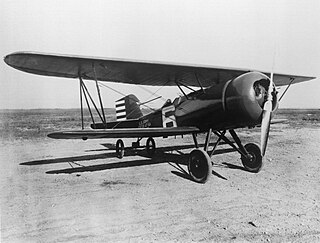Design and development
The G-15 inherited the monocoque fuselage and low, two spar, partially plywood covered wings of the earlier G-5 and G-8 but was a bigger and heavier aircraft, the first Gribovsky had designed for touring rather than sport and training. Unlike the smaller machines the G-15 had seats for two, arranged side-by-side. [1]

Monocoque, also structural skin, is a structural system where loads are supported through an object's external skin, similar to an egg shell. The word monocoque is a French term for "single shell" or "single hull". First used in boats, a true monocoque carries both tensile and compressive forces within the skin and can be recognised by the absence of a load-carrying internal frame.

The fuselage is an aircraft's main body section. It holds crew, passengers, and cargo. In single-engine aircraft it will usually contain an engine, as well, although in some amphibious aircraft the single engine is mounted on a pylon attached to the fuselage, which in turn is used as a floating hull. The fuselage also serves to position control and stabilization surfaces in specific relationships to lifting surfaces, which is required for aircraft stability and maneuverability.

Plywood is a material manufactured from thin layers or "plies" of wood veneer that are glued together with adjacent layers having their wood grain rotated up to 90 degrees to one another. It is an engineered wood from the family of manufactured boards which includes medium-density fibreboard (MDF) and particle board (chipboard).
Following earlier Gribovsky practice, the wing centre section was an integral part of the circular cross-section fuselage and, like it, was ply covered. The outer wing panels were ply covered from the leading edge back to the rear spar, with the rest fabric covered. In plan the wings were strongly tapered, mostly on the trailing edges, and ended in long, elliptical tips. Their trailing edges carried slotted flaps inboard; slotted ailerons filled the rest of the span. Fuel tanks were located between the spars, two in each wing. [1]

The leading edge is the part of the wing that first contacts the air; alternatively it is the foremost edge of an airfoil section. The first is an aerodynamic definition, the second a structural one. As an example of the distinction, during a tailslide, from an aerodynamic point of view, the trailing edge becomes the leading edge and vice versa but from a structural point of view the leading edge remains unchanged.

Aircraft fabric covering is a term used for both the material used and the process of covering aircraft open structures. It is also used for reinforcing closed plywood structures, the de Havilland Mosquito being an example of this technique, and on the pioneering all-wood monocoque fuselages of certain World War I German aircraft like the LFG Roland C.II, in its wrapped Wickelrumpf plywood strip and fabric covering.

The trailing edge of an aerodynamic surface such as a wing is its rear edge, where the airflow separated by the leading edge rejoins. Essential flight control surfaces are attached here to control the direction of the departing air flow, and exert a controlling force on the aircraft. Such control surfaces include ailerons on the wings for roll control, elevators on the tailplane controlling pitch, and the rudder on the fin controlling yaw. Elevators and ailerons may be combined as elevons on tailless aircraft.
The G-15 was powered by a 115 kW (154 hp) Shvetsov M-11 five cylinder radial engine driving a two blade propeller, housed under a broad chord NACA cowling. The cockpit was over the wing, with a fairing behind it dropping smoothly to the underlying fuselage line. The fin, also ply covered and an integral part of the fuselage, had a curved leading edge and carried a slightly taller, unbalanced rudder. A straight edged tailplane, mounted mid-fuselage, carried rounded elevators. Both rudder and elevators were fabric covered. The G-15 had a fixed, wide track tail skid undercarriage, with its vertical, wing-mounted main legs in trouser type fairings which widened to form spats enclosing the wheels. [1]

The Shvetsov M-11 is a five-cylinder air-cooled radial aircraft engine produced in the Soviet Union between 1923 and 1952.

The radial engine is a reciprocating type internal combustion engine configuration in which the cylinders "radiate" outward from a central crankcase like the spokes of a wheel. It resembles a stylized star when viewed from the front, and is called a "star engine" in some languages. The radial configuration was commonly used for aircraft engines before gas turbine engines became predominant.

The NACA cowling is a type of aerodynamic fairing used to streamline radial engines for use on airplanes and developed by the National Advisory Committee for Aeronautics in 1927. It was a major advance in aerodynamic drag reduction, and paid for its development and installation costs many times over due to the gains in fuel efficiency that it enabled.
The G-15 was built at the glider works in Moscow in 1934. Both its design and performance were praised but, like most of Gribovsky's designs, it was not put into production. The sole example is known to have made a successful forced landing after an engine failure during a 1935 flight near Moscow, but it is not known if it flew again. [1]

Moscow is the capital and most populous city of Russia, with 13.2 million residents within the city limits, 17 million within the urban area and 20 million within the metropolitan area. Moscow is one of Russia's federal cities.





